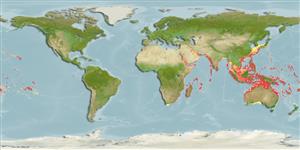Environment: milieu / climate zone / depth range / distribution range
Ökologie
seewasser riff-verbunden; tiefenbereich 0 - 135 m (Ref. 89972), usually 1 - 12 m (Ref. 90102). Tropical; 38°N - 36°S, 19°E - 124°W
Indo-Pacific: Red Sea and East Africa to the Hawaiian, Marquesan and Ducie islands, north to the Ryukyu and Ogasawara islands, south to the Great Barrier Reef, Lord Howe, and Rapa.
Size / Gewicht / Alter
Maturity: Lm ? range ? - ? cm
Max length : 32.0 cm SL Männchen/unbestimmt; (Ref. 1602)
Rückenflossenstacheln (insgesamt): 0; Rückenflossenweichstrahlen (insgesamt): 11-12; Afterflossenstacheln 0; Afterflossenweichstrahlen: 9 - 10. Posterior part of body with blackish blotches; dorsal, caudal and pelvic fins with dark traverse bands (Ref. 11228).
Inhabits sand and silty reefs (Ref. 58652). Benthic (Ref. 58302). Common in shallow lagoons, reef flats, and sheltered seaward reefs. Feeds on fishes and ocacionally on crustaceans (Ref. 89972). Active at night (Ref. 5213). Caught with artisanal gear. Solitary (Ref 90102).
Life cycle and mating behavior
Geschlechtsreife | Fortpflanzung | Ablaichen | Eier | Fecundity | Larven
Cressey, R.F., 1986. Synodontidae. p. 270-273. In M.M. Smith and P.C. Heemstra (eds.) Smiths' sea fishes. Springer-Verlag, Berlin. (Ref. 4055)
IUCN Rote Liste Status (Ref. 130435)
Bedrohung für Menschen
Harmless
Nutzung durch Menschen
Fischereien: kommerziell
Mehr Information
NamenSynonymeMetabolismusRäuberÖkotoxikologieFortpflanzungGeschlechtsreifeAblaichenSpawning aggregationFecundityEierEientwicklung
ReferenzenAquakulturAquakultur ProfilZuchtlinienGenetikElectrophoresesVererbbarkeitKrankheitenVerarbeitungNutrientsMass conversion
Tools
Zusatzinformationen
Download XML
Internet Quellen
Estimates based on models
Preferred temperature (Ref.
123201): 24 - 29, mean 28 °C (based on 2080 cells).
Phylogenetic diversity index (Ref.
82804): PD
50 = 0.5000 [Uniqueness, from 0.5 = low to 2.0 = high].
Bayesian length-weight: a=0.00724 (0.00487 - 0.01078), b=3.12 (3.00 - 3.24), in cm total length, based on LWR estimates for this species & Genus-body shape (Ref.
93245).
Trophic level (Ref.
69278): 4.2 ±0.4 se; based on diet studies.
Widerstandsfähigkeit (Ref.
120179): mittel, Verdopplung der Population dauert 1,4 - 4,4 Jahre. (Preliminary K or Fecundity.).
Fishing Vulnerability (Ref.
59153): Low to moderate vulnerability (29 of 100).
Nutrients (Ref.
124155): Calcium = 48.9 [17.7, 98.6] mg/100g; Iron = 0.499 [0.175, 1.082] mg/100g; Protein = 15.2 [12.8, 17.7] %; Omega3 = 0.0667 [, ] g/100g; Selenium = 37.5 [15.0, 84.8] μg/100g; VitaminA = 109 [28, 353] μg/100g; Zinc = 0.915 [0.529, 1.379] mg/100g (wet weight);
